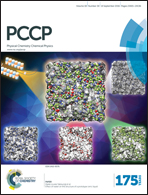The limiting conductivity of the borate ion and its ion-pair formation constants with sodium and potassium under hydrothermal conditions
Abstract
Frequency-dependent molar electrical conductivities for aqueous solutions of potassium borate, and sodium borate have been measured from ambient to near-critical temperatures and pressures to an accuracy of ±3 percent, using a unique high-precision flow-through AC conductance instrument. The concentration dependence of these conductivities was analyzed with the Turq–Blum–Bernard–Kunz (“TBBK”) theoretical model to yield (i) limiting conductivities of the borate ion, λ0[B(OH)4−], and (ii) ion-pair formation constants, KA, for the species NaB(OH)04 and KB(OH)04 from T = 298 K to T = 623 K at a constant pressure p ∼ 20 MPa. The ion-pair formation constants for both borate salts were found to be consistent with previous literature studies at temperatures below 473 K. No significant difference in KA was observed between the species NaB(OH)04 and KB(OH)04. As temperature was increased from 473 up to 623 K, the degree of association increased significantly, and was found to be considerably higher than for any other 1-1 electrolyte previously studied. For instance, at 623 K, the association constant log KA[NaB(OH)04] = 2.75 ± 0.21 was an order of magnitude higher than log KA[NaCl0] = 1.53 ± 0.03, and approximately equal to that of a 2 : 1 electrolyte, log KA[SrCF3SO3+] = 2.58 ± 0.06. Deviations in the limiting conductivities from Stokes Law show that the borate ion's unusual “structure making” effect, observed by other workers at sub-ambient conditions, persists up to temperatures above 500 K. The temperature dependence of the Walden product ratio is very different from that observed for other monovalent anions for which experimental data are available over this wide range of temperatures.


 Please wait while we load your content...
Please wait while we load your content...